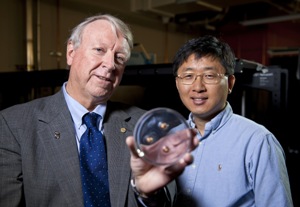Dec 13 2013
Strategies to manipulate light and sound go back to the first spherical glass bead and the pounding of the first hollow log. But their full potential is only just becoming apparent, according to a review by materials scientists at Rice University and their colleagues.
 Rice University scientists Ned Thomas (left), dean of the George R. Brown School of Engineering, and Jae-Hwang Lee are the primary authors of a new review of photonic, phononic and phoXonics research in the journal Advanced Materials. (Credit: Tommy LaVergne/Rice University)
Rice University scientists Ned Thomas (left), dean of the George R. Brown School of Engineering, and Jae-Hwang Lee are the primary authors of a new review of photonic, phononic and phoXonics research in the journal Advanced Materials. (Credit: Tommy LaVergne/Rice University)
New abilities to corral light and sound from the macroscale to the nanoscale with structured polymers could deliver profound changes in the way we live, said materials scientist Edwin “Ned” Thomas, the William and Stephanie Sick Dean of the George R. Brown School of Engineering at Rice. Such advanced materials could not only revolutionize computing and sensing technology but could also bring about new strategies for soundproofing buildings and cars, managing heat and cold and making submarines invisible to sonar, he said.
“And then there’s the invisibility cloak, like in ‘Harry Potter,’” Thomas said. “That’s a special effect in the movie, but we’re getting to the point where we can do it for real.”
Thomas and Rice research scientist Jae-Hwang Lee are primary authors of the comprehensive summary of research into photonics (light), phononics (sound) and hybrid phoXonics (light and sound) materials. The chapter-length, open-access review titled “Ordered Polymer Structures for the Engineering of Photons and Phonons” was published online today by the journal Advanced Materials.
Manipulating light has been around for a long time, said Thomas, who specializes in polymeric materials. “Photonics made a significant advance by showing we can confine light and make it go where we want it to go,” he said. “Now we’re molding the flow of elastic waves – of which sound is a subset – in similar ways. And there’s growing emphasis on devices that handle light and elastic waves simultaneously to do cool things – not with one or the other, but with both.”
The review follows by four years a book on the topic by Thomas and Massachusetts Institute of Technology (MIT) colleague Martin Maldovan. “There have been a lot of advances since then,” Thomas said. “When we were asked by the journal to do this, I told the editor I didn’t think it was going to be a short review.”
He was right. The review cites more than 400 papers as it details dozens of theories and suggests techniques for the manufacture of devices, along with a few original ideas “we wanted in the literature,” Thomas said.
The review primarily deals with photonics and its close relative, plasmonics, a topic of great interest at Rice’s Laboratory for Nanophotonics. But the last third of the paper dives into phononics. Treating sound waves somewhat like light waves is a fairly recent approach in materials science, but research into the nanoscale manipulation of sound using materials with periodic mechanical impedance is rising quickly, Thomas said.
“Phononics for sound is probably even more practical than photonics for light, in a way,” he said. “Everybody wants to control sound: either get rid of it, enhance it or filter certain frequencies. And this field’s moving fast.”
The review shows the breadth of research into fashioning polymers that create band gaps for sound and light similar to those that give semiconductors their unique electronic properties. A band gap can be tuned by patterning the materials via a number of techniques to allow only particular frequencies of sound or light to pass through while blocking all others.
The ability to control such properties on the micron scale could make a soundproofing material nearly as thin as a layer of paint, Thomas said. In fact, for some applications it could direct rather than absorb: These thin materials would guide sound waves around an object and emit them on the far side.
That would make submarines effectively invisible, he said. “Normal materials that essentially absorb sound are thick and big. Just look inside any concert hall. With phononics we should be able to make metamaterials that are just as effective but in a smaller form factor. You can’t coat a submarine with a 300-foot-thick membrane over the entire hull. But if you could coat it with something half-a-centimeter thick, game on.”
Thomas thinks scientists are on the brink of a materials revolution, and the new paper presents plenty of evidence. “This excites me because we’re not just making incremental improvements to known properties; usually, materials science is about the material and the structure and whatever makes sense for the application. But we’re flipping that. The boundaries we know about don’t contain all the solutions. There are things beyond our mindset that contain answers to questions we haven’t even imagined.
“The people I work with – the physicists, electrical engineers, materials scientists, chemists – they’re all excited about this because they know there are probably way more surprises in the future,” he said.
Co-authors are Rice postdoctoral researchers Seog-Jin Jeon and Ori Stein; Yale University postdoctoral researcher Jonathan Singer; Cheong Yang Koh, a researcher at DSO National Laboratories in Singapore; and Maldovan, a research scientist at MIT.
The Asian Office of Aerospace Research and Development through the Defense Thread Reduction Agency and the U.S. Army Research Office through the Institute of Soldier Nanotechnology at MIT supported the research.